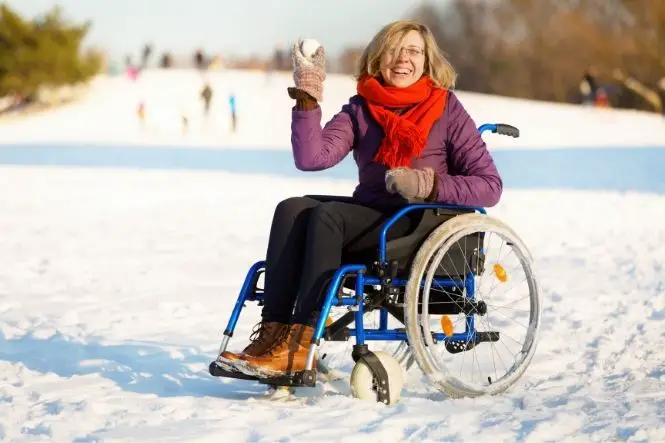Whether you’re planning a holiday in a snowbound location or just trying to get around closer to home, travelling through snow can present a lot of problems. Sometimes the best advice is simply not to try it, but it’s important to be informed when you make that call, and there are a number of things you can do to increase your independence. Rather than being trapped by snow, you may be able to enjoy it like so many other people do.
Walking in Snow
Walking in snow can be challenging for anyone, but it’s particularly difficult if you have impaired mobility or problems with balance. Most people find it easy to keep their footing in new, crunchy snow, or on snow that has fallen over grass. Trampled-down or partially melted snow, however, can be very slippery, especially over tarmac. It’s important to remember that fresh snow may have old, slippery snow underneath it.
Using a walking stick can help you to balance in snow, but because they only make contact with a small area of ground, most sticks don’t grip very well. It’s important that your stick has a new, good quality gripping foot, or that it has a specially adapted foot for use on ice – some sticks even have spikes. Remember that a stick that is secure on ice may be less secure on other surfaces; you may need to carry two stick feet and change them as required.
Most falls in snow occur when people are off balance because weight is being shifted from one foot to the other. Take smaller steps and move your feet slowly so that you always have one foot anchored as firmly as possible on the ground. Stay close to walls or railings wherever possible so that there’s something solid you can grab if you slip. Keep a mobile phone with you in case of emergency.
Wheelchairs, Mobility Scooters and Snow
Wheelchairs and mobility scooters vary quite a bit in their ability to cope with snow. As a rule, most lightweight models (which includes most of the cheaper ones on the market) cannot cope with anything more than a couple of inches. Light wheelchairs will handle snow better when they are being hand-wheeled or pushed than when moving under their own power. If in doubt, contact the manufacturer for advice.
Heavier wheelchairs and mobility scooters can usually cope with around six inches of snow. If you are going on holiday to a destination where deep snow is the norm, bear in mind that there will usually be paths kept clear below this level, so you may find it easier to get around than you do in similar conditions at home. If possible, dust caked-on snow off your tyres as soon as you get in and be pro-active with maintenance to avoid rust.
Whenever you go out in heavy snow, or whilst it is still snowing, have a back-up plan in case your wheelchair or mobility scooter gets stuck. Keep a taxi number with you and make sure there’s a carer, friend or relative you can call if you need assistance.
Driving in Snow
Driving in snow is always risky but can present extra problems for disabled people because you may find it harder to abandon your car if you get stuck. Pay careful attention to weather warnings before you set out and make sure that, wherever you go, you have an insurance policy that guarantees prompt rescue. Some providers will register you as a priority customer at no extra cost.
If you are driving an automatic, bear in mind that it may handle less well in snow than a manual transmission vehicle. This means it may sometimes be better to travel in a different car with someone else driving, even if you prefer to do it yourself. In either case, take plenty of warm clothes, a blanket, a flask of hot drink, some food and any medication you need – it’s always best to be prepared.
Fun with Snow
Having a disability may make snow hard work sometimes, but it needn’t stop it being fun. High-seated sleds are accessible and safe for most disabled people and can give you thrilling downhill rides. You can also try skiing on special adapted platforms that enable you to distribute your weight without needing the strength in your legs that other skiers do. You might not be able to tackle the toughest slopes, but you can still have a great time.

